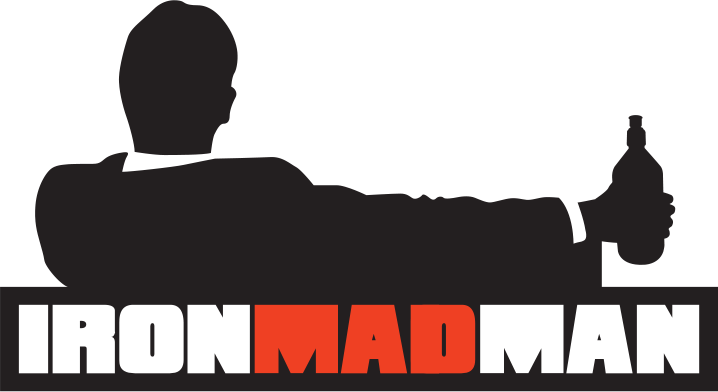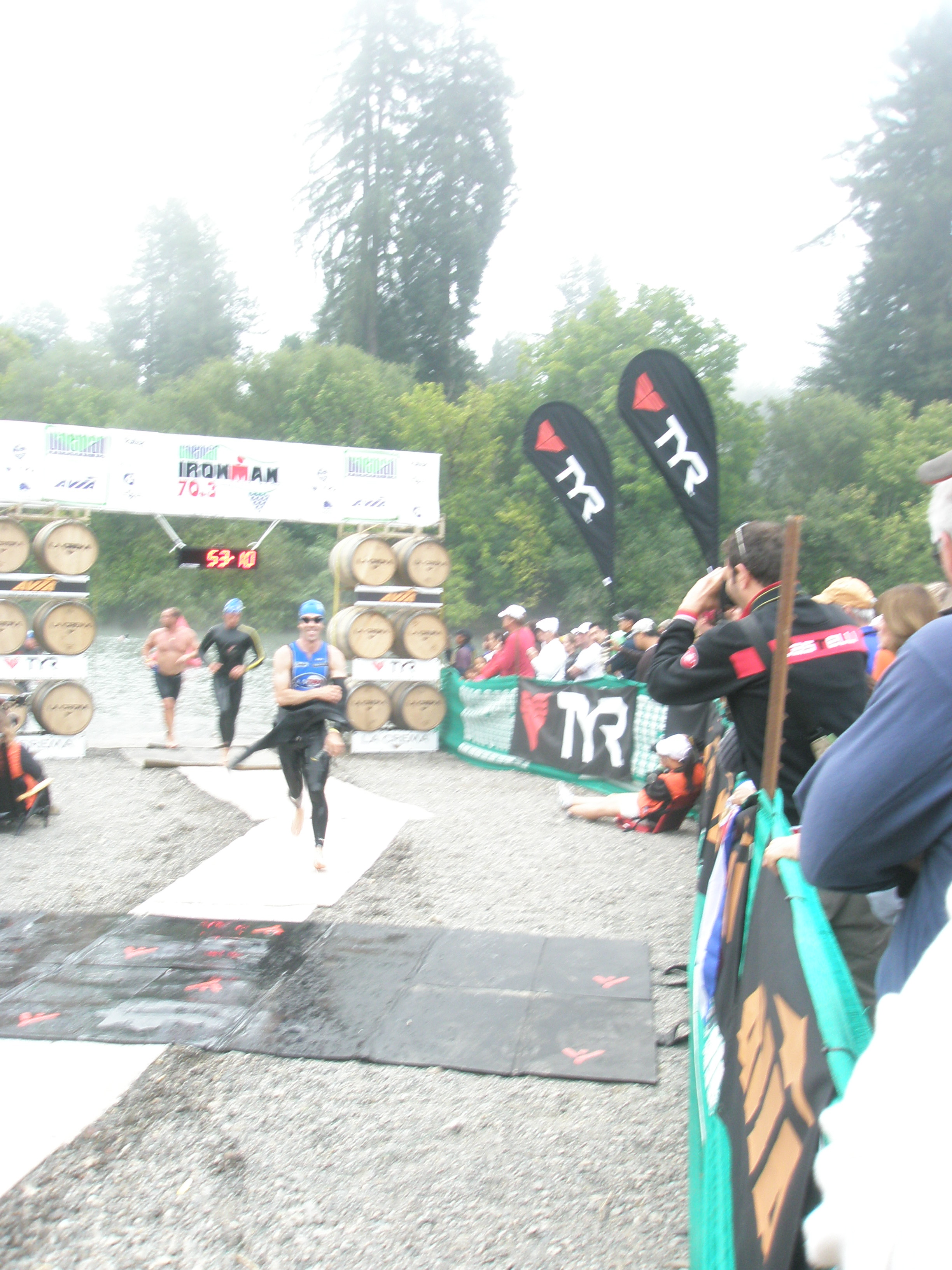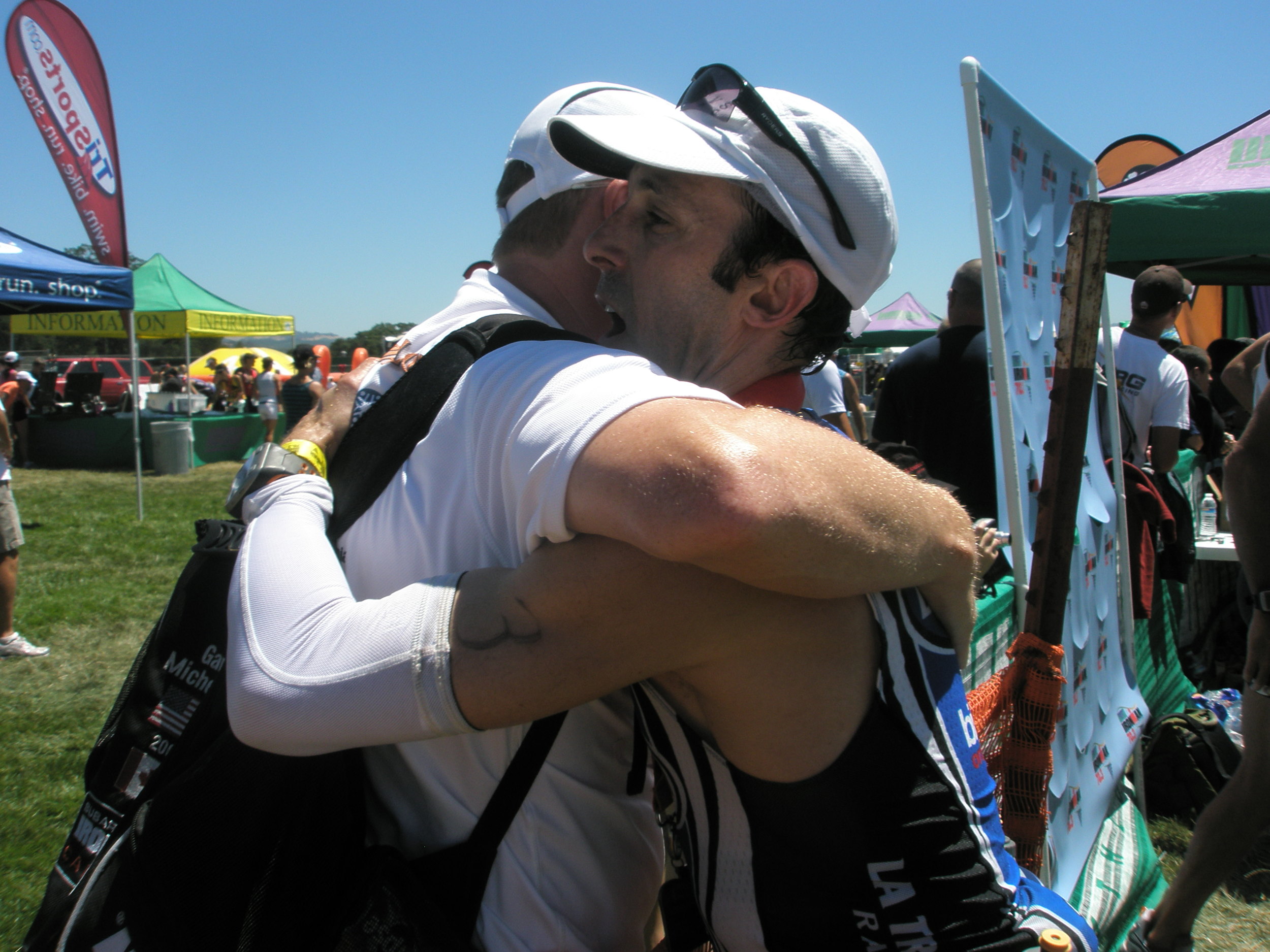From Tin to Steel Man: Part II
/This is the second in my three-part series on Vineman 70.3. Yesterday, I wrote about my pre-race experience. Today's blog is all about the race itself, including tips for my friends competing at Vineman Full in 10 days. I'll break it out between the Swim, Bike and Run for quicker reading. SWIM
Race day morning felt surreal. All this training and preparing were leading to the penultimate moment. It wasn't even a full Ironman but I was nervous as if it was. I tried to stick to my normal pre-race routines to keep me calm. That helped, but what helped more was having Rusty and Stephanie there to deflate the tension building inside. It got so bad that I had to use the restroom three times, twice at the race site.
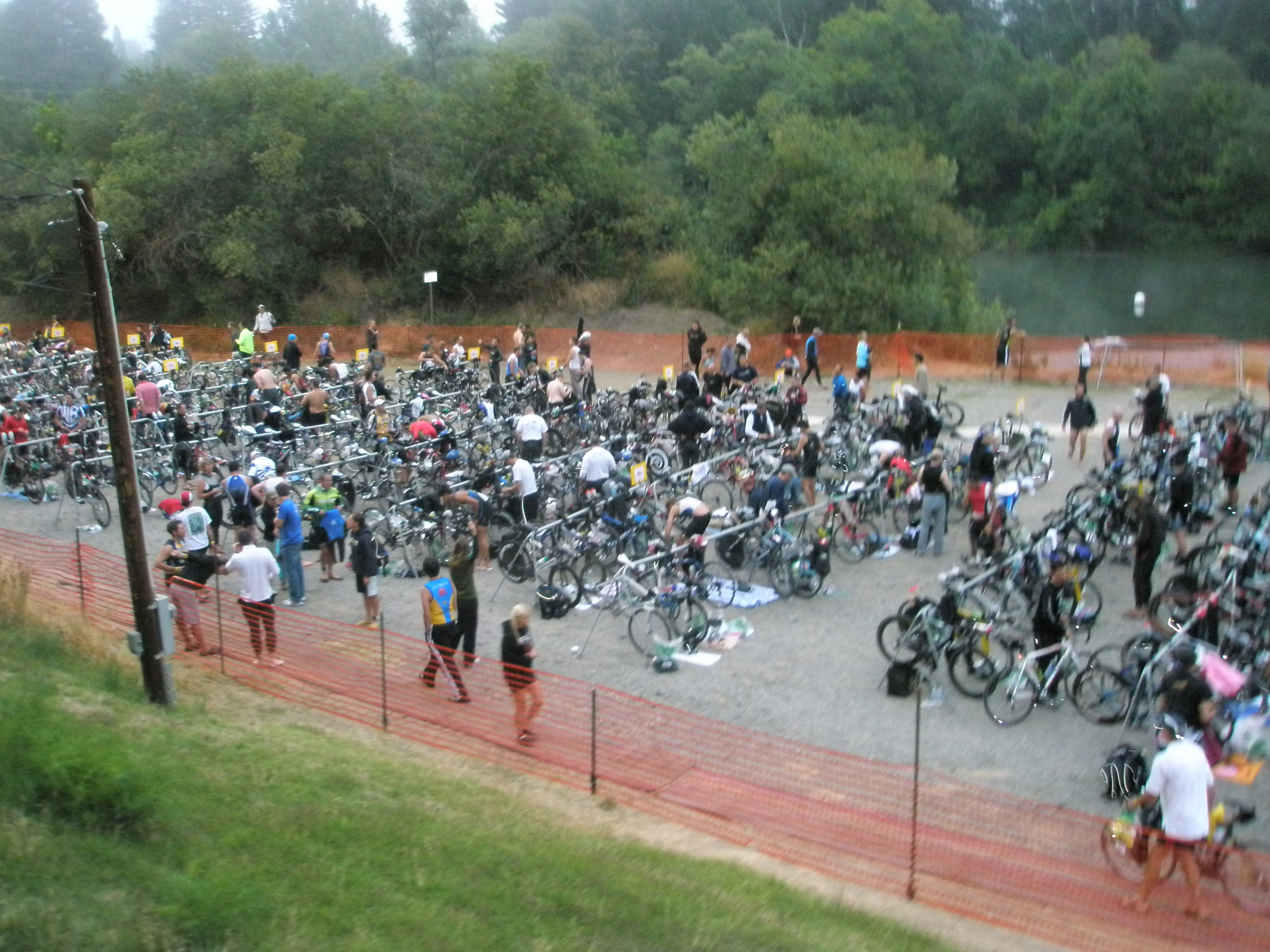 We arrived at Johnson's Beach at 5:30 a.m. just as the transition area opened, which I'd recommend for Vineman Full competitors. There's only one road into Guerneville, and waves start promptly at 6:35 a.m. If you're staying in Santa Rosa it will likely take you at least 20 minutes from the 101 Freeway. You'll want to have enough time, as I did, to avoid the port-o-potty lines, claim a choice spot in the crowded transition area and organize. If you're in one of the earlier waves like I was, you'll also appreciate having a less crowded area to allow you to concentrate for a few moments about the race ahead.
We arrived at Johnson's Beach at 5:30 a.m. just as the transition area opened, which I'd recommend for Vineman Full competitors. There's only one road into Guerneville, and waves start promptly at 6:35 a.m. If you're staying in Santa Rosa it will likely take you at least 20 minutes from the 101 Freeway. You'll want to have enough time, as I did, to avoid the port-o-potty lines, claim a choice spot in the crowded transition area and organize. If you're in one of the earlier waves like I was, you'll also appreciate having a less crowded area to allow you to concentrate for a few moments about the race ahead.
That's what I was doing when Stephanie snapped this image of me just minutes before I waded into the water for my wave start.
I think this image captures my emotion better than any words I could muster.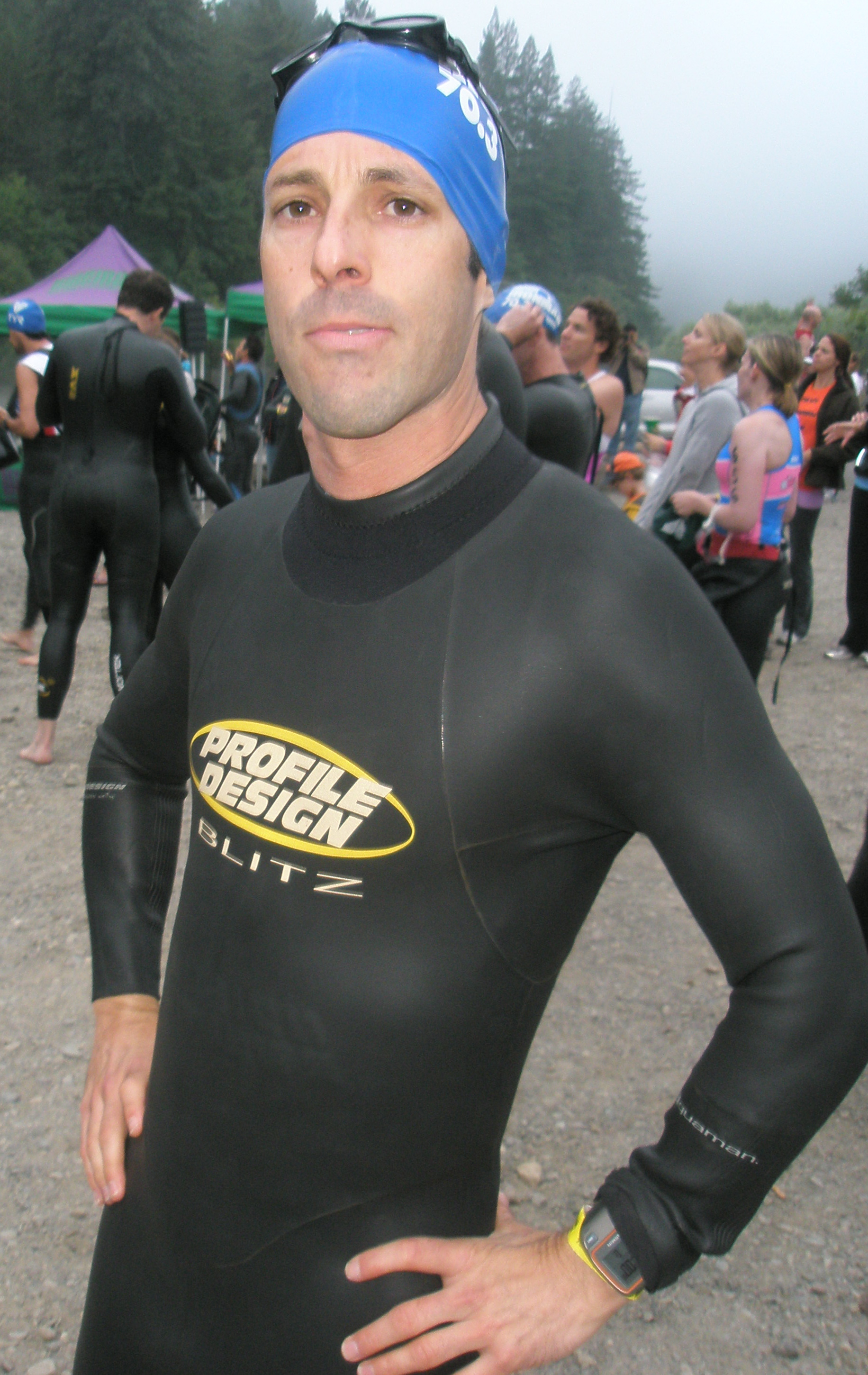
Vineman marked my first swim start where I didn't have to run into the ocean. We floated in place for about five minutes before the gun sounded. I actually liked this better because there was much more room for competitors to find open water. There wasn't the usual free-for-all scrum, which enabled me to find my breathing pattern much quicker without expending too much energy fighting for position.
Swimming in the Russian River was my most enjoyable race day swim yet. The water temperature felt almost tepid. My mouth and throat didn't sting from salt. I didn't get kicked. And the scenery was beautiful. Besides, where else can you simply stand up and walk when you feel like taking a breather?
That said, I could feel the difference between a 1.2-mile swim and an Olympic-distance .93 miler. I thought for 10 minutes I should be hitting the half-way point before I actually did. And then I walked the 25 yards between buoys along with several others before resuming my underwater effort. There were several points where I debated walking even more. I'm glad I resisted. As I swam I really focused on calm breathing and an even cadence. I preserved my energy nicely, and exited the water with my Garmin watch showing 35:40, a full 1:20 faster than Coach Gerardo's estimated 37-minute pace. However, with the mat time I literally hit 37:02, my coach called my time within two seconds. That's impressive.
BIKE
The transition from swim to bike was almost laughably slow. I promised myself going into this race that I would savor the experience more than I had in the past. To me, this meant soaking up the moment in the transition areas. Pausing to relish in completing a 1.2 mile swim while psyching myself up for the 56 mile bike ride. I certainly did that, as my five-minute T1 attests. To be fair, I put on arm coolers, which I typically don't do, and wouldn't recommend in the future. Either wear them underneath your wetsuit or don't wear them at all. It's not worth the wasted time.
The T1 area is a zoo. You have people preparing for their wave while you're trying to get the hell out. Just like freeway traffic, you have rubberneckers and jerks trying to weave through everyone. I was trying to be courteous to the slow pokes in front of me since there's only one route out of the T1 on a thin slice of old carpet from the 1970s. The cyclist in front of me was literally walking his bike though and I couldn't stand it anymore. I grunted an obscenity to myself and ran through the dirt next to the carpet to exit the area quicker. I recommend this approach for anyone trying to hit a specific time.
Another tip: Don't ride up the embankment leading out of T1. It's quicker to run, and ultimately safer. Several people tried to ride up the small but steep hill. It's a poor way to warm up your legs and people are wobbling all over the place trying to mount. Better to be agile and avoid the chaos by scurrying out of the way when they're about to tip over.
To me the first five miles of the Vineman bike ride were extremely important. There were several slower riders in front of me from the previous wave who crowded the narrow road. I knew there'd be little room to pass once we made the sharp right turn onto Sunset Road, so I decided to stay to the left and pass dozens of riders all at once. It forced me to pedal harder than I expected initially, but it was the right call since it would have been even tougher to pass on the hilly climbs for the next few miles. Besides, I get more anxious riding behind slower cyclists. It makes me think I'm losing time.
Rather than analyze the entire route, I'll say this about the Vineman 70.3 bike course: I personally found it easier than I expected. When you drive the course, the many rolling hills seem like they'll sap your energy over time. The truth is, if cycling is your specialty, you'll be fine. Don't be intimidated by the seemingly long climbs and false flats. If you ride the many hills throughout Malibu and Mulholland Drive, you'll be prepared. The hardest hill on the 70.3 course, which occurs around mile 42 past the Chalk Hill sign, is no steeper nor more challenging than the hill leading up Portrero Road in Hidden Valley near Sly Stallone's home. As the race course preview indicates, this hill will reveal if your bike training paid off. Nothing more, nothing less.
At Vineman, I learned once and for all that cycling is my specialty. I can pedal for hours at a fairly strong pace and not get winded. I can make up my time from a mediocre swim and set myself up for a strong run finish. If it wasn't for losing four water bottles off my back cages, I would have rode even harder. I past far more cyclists than those who past me. I honestly think I can count on one hand the number who flew by me and kept going. I was pleasantly surprised by this.
Back-tracking for a moment, I highly recommend using frame-mounted bike cages for Vineman. If you only have one cage on your frame, like me, purchase another. There are too many bumps in the road that can suddenly leave you without proper hydration. I lost my regular water bottle over a bridge bump. Then, I lost three volunteer-supplied plastic water bottles from various bumps and holes on the rest of the course. I was forced to ration a quarter of my frame-mounted water bottle containing warm Perpetuem for the last 15 miles. This would hurt me on the run, as I clearly hadn't drank enough. This brings me to another tip, if you wear a race watch, set the alarm to remind you to drink on the bike every 10-15 minutes (or whatever pace you chose). Of course, be prepared to hold your bladder! In the future, I'll lower my scheduled drinks from 15 to 10 minutes. I clearly need to hydrate more, having essentially only drank 1.5 water bottles' worth of fluid in nearly three hours on the bike.
The thing I'll remember most about the bike though was the final few miles. It was there, just next to the Windsor cemetery, that I realized I wasn't merely going to finish in six hours like I had hoped, but that I had a real shot at eclipsing 5:30. This was a powerful moment for me, for it was only then, going on 3.5 hours into the race, that I knew my Vineman 70.3 race was going well. It's so hard to tell in the heat of the action. You just swim, pedal or run your heart out, as the minutes whirl by at what feels like mach 3 speed. So that moment where you know your bike isn't going to break down and that you've ridden yourself into a virtual guarantee of meeting your goal is unforgettable. I wanted to raise both arms triumphantly when I rode into the T2 lot as if I had just won a Tour de France stage.
Just then, I saw Chris Lieto running into T2 after running a 1:16 half marathon.
RUN
I enjoyed another leisurely transition by sauntering to a port-o-potty before beginning my run. Once again, I had decided to adhere to Gerardo's advice about pacing myself and enjoying the moment. I thoroughly did with a four-minute T2. I'm usually two minutes faster, but at this point I didn't really care since I knew I'd break six hours.
The run was by far the toughest part of my day. I started just shy of 11 a.m. as the clouds were burning off and the temperature rose rapidly. The first four miles of the run flew by. My adrenaline was rolling, my body felt great and I my entire race experience just couldn't have been going better. But around the fifth mile, that all-too-familiar tinge from my left IT band started to twitch. The first signs of malnutrition and fatigued set in. Thankfully, I was drinking plenty of fluids at each mile marker aid station, along with walking for 30 seconds as Gerardo advised. This allowed me to calm my heart rate and allow my legs to relax just a bit. I honestly think this saved me from bonking. While it's hard to let others speed by you, using my head and not my heart in this situation made a huge difference in my overall race.
Speaking of nutrition and hydration, I'd recommend that if you're not drinking Gatorade now, you may want to consider it. The course volunteers will hand it out liberally at the aid stations and it's hard to resist when you're feeling low. Since you have to store your T2 running gear the night before, it's an easier call to avoid using a fuel belt filled with warm Heed or Perpetuem from the night before. Might as well get fresher, colder liquids out on the course, and you can run with less weight. I will embrace this approach at Vineman in the future. I never filled my empty fuel belt bottles with Gatorade or water.
I wish I had around the eighth and ninth miles. The sixth and seventh miles have no shade whatsoever, and as the sun blazed without obstruction overhead, I started to wilt. My legs became heavier. My stride shortened and tightened. It was at this moment I knew it was my body against my brain for the next 45 minutes. I'd have to resort to mental trickery and compromises to avoid cramping and bonking. I'd play games like telling myself I could walk for 40 seconds if I could just make it to that second mailbox beyond that third hill up ahead. And then once I got to that second mailbox, I'd will myself to get to that shady tree 200 yards up for that well-deserved break.
That approach worked fairly well until mile 10. Then, I started to really lock up. I began to worry that I might not be able to continue my 9-minute-mile pace. I actually began to worry I might not finish the race. My right quad was screaming, as was my right calf. My left IT band was so tight I almost had to sweep my legs around in front to gain momentum. I was in pain.
Then, around the 11th mile, I started to see my friends both in Fortius and the LA Tri Club. This was an enormous pick-me-up. Many shouted my name or encouraged me to keep going even if they didn't know me. This gave me the strength to find new energy and do them proud. I bargained my way through the 11th and 12th miles until I reached the final stretch. I paused at the last aid station, dumped another cup of water on my head after drinking more Gatorade, and said out loud to nobody in particular: "Everything. You. Have. Right. Now."
And I sprinted as pathetically fast as I could. Every thought of pain was ignored. I stopped looking at my watch, because I didn't want to even consider what my heart rate might be. My legs buckled twice in the parking lot before entering the finishing chute. I literally said out loud, "NO" as I continued to run with every bit of strength I could manage. I grit my teeth and kept chugging.
I finally crossed from the pavement to the dirt to the grass that indicated the last 200 yards to the glorious Vineman 70.3 Finish time clock. I was going to break six hours by nearly 30 minutes! I was about to complete my first Half Ironman! I heard my name announced once I crossed the timing mat, "Ryan Schneider from Sherman Oaks!" I let out a primal scream from the depths of my guts at that point. Arms outstretched, fingers tensed, mouth wide open, I strutted through the line.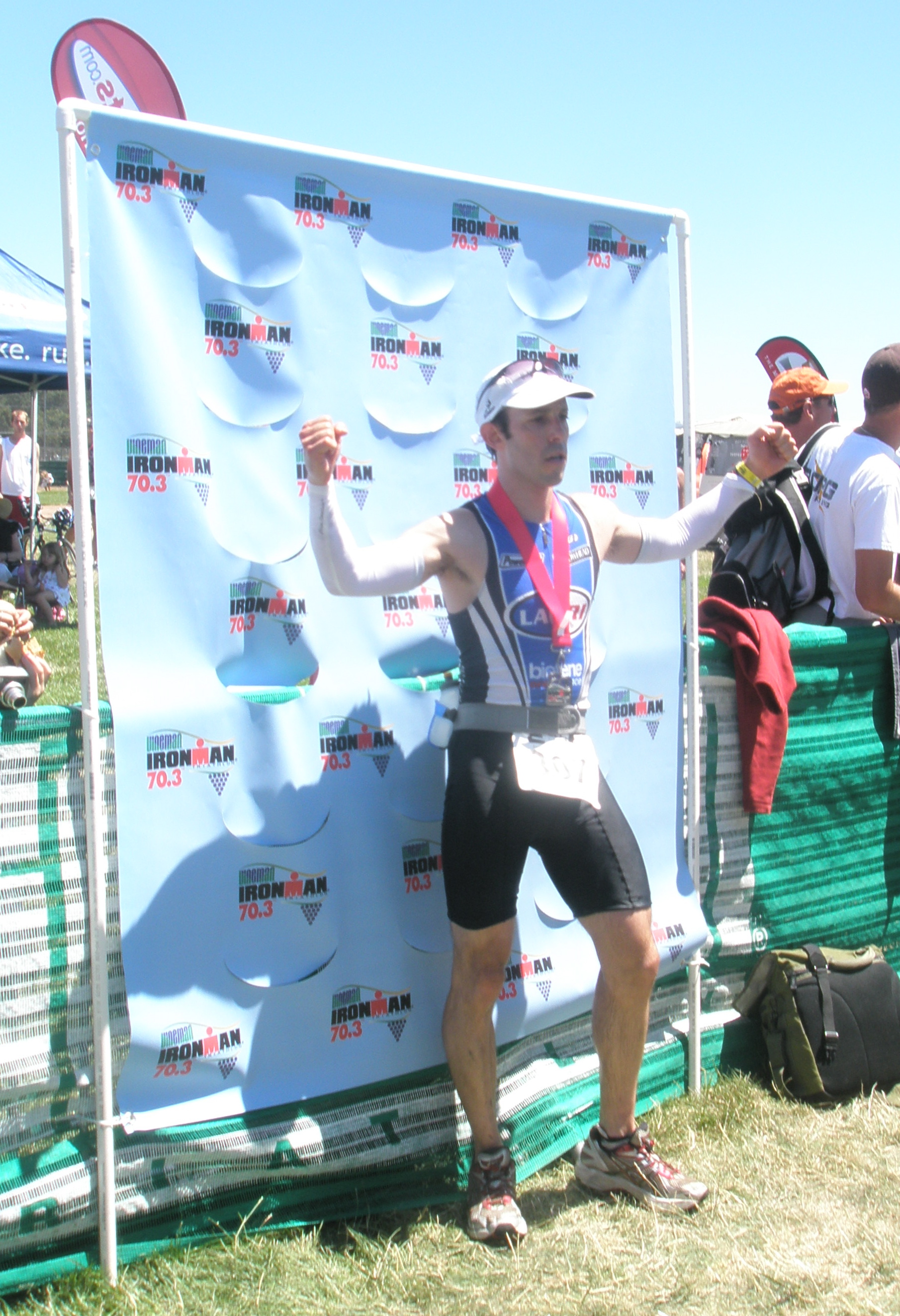
5:33:36!
I am a Half Ironman!
I am a Half Ironman!
And then my legs buckled completely. My body practically gave out on the spot. A nurse came over to see if I was OK.
I was better than OK. I was a broken, hot, exhausted, pained mess. I was dehydrated to the point that after two quarts of Gatorade following the race I still wouldn't pee for another hour, three hours total post-finish. I needed two bags of ice on my legs so I could walk without locking up. I barely made sense to Rusty and Stephanie when talking at first.
But it didn't matter one bit. I reached my goal and exceeded it. I experienced physical pain for an extended period and pushed past it. I challenged myself and won.
I am a Half Ironman.
And yet it is not good enough. It is not the full journey. It is not the final destination.
That comes in four months.
I am a Half Ironman...not a full one.
Yet.
122 days and counting.
